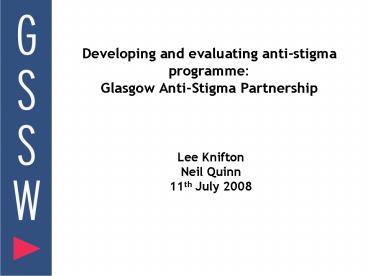Developing and evaluating antistigma programme: Glasgow AntiStigma Partnership - PowerPoint PPT Presentation
1 / 14
Title:
Developing and evaluating antistigma programme: Glasgow AntiStigma Partnership
Description:
The largest mental health arts festival of its kind ... Arts festivals and large scale events ... Arts festival. Build upon good practice. Engage different ... – PowerPoint PPT presentation
Number of Views:36
Avg rating:3.0/5.0
Title: Developing and evaluating antistigma programme: Glasgow AntiStigma Partnership
1
Developing and evaluating anti-stigma
programme Glasgow Anti-Stigma Partnership
- Lee Knifton
- Neil Quinn
- 11th July 2008
2
Glasgow anti-stigma partnership
- Community of practice and learning
- Over 70 partner organisations
- Service user, mental health, community
development, education, arts, economic
development and many more..whose problem is
stigma?
3
How we work
- Service user empowerment
- Shared decision making
- active partnership from organisations
- Acknowledging different concepts of mental health
and wellbeing - Organised into settings and thematic teams
- Robust research with academic partners,
publication and learning
4
What is stigma?
- Knowledge
- Attitudes
- Discriminatory behaviour
- Self stigma
- Interpersonal (family and community)
- Structural
5
Stigmatising beliefs
- Dangerous
- Blame
- Recovery pessimism
- Oddness
- Lack of capability or social contribution
- Unable to maintain relationships
- Weak/pitiful
- Shame
- Contagion
6
Is stigma prevalent?
- Broadly positive expressed attitudes in the
Scottish Public Attitudes Survey (2006) - But significant public discrimination including
harassment (Berzins et al 2003) - High unemployment rates
7
What works in addressing stigma
- Combine national, regional and local approaches
- Education messages must be clear, targeted,
positive and focus upon recovery - positive personal contact with service users
leading in campaigning activities emotional
engagement through narratives - (Link Phelan 2001, Penn and Martin 1998, Gale
et al 2004)
8
General principles
- Moving from stigma to discrimination
- Moving from top down work to community
development approaches - Moving from advertising and media to positive
contact, empowerment, narratives and engagement - From negative dont stigmatise messages to
positive ones - Involving non-mental health organisations from
outset - influences scope, scale and
sustainability of activity
9
Aspirations
- 4 lessons a year for each young person
- Peer support in each school
- Multi-media campaigns in workplaces
- Thousands of people taking equality workshops
- The largest mental health arts festival of its
kind - Community development with refugees and asylum
seekers - Addressing stigma with ethnic minority
communities -research, community conversation
workshops, faith leaders, arts events,
storytelling and empowerment - Awareness raising with the 6 regional
universities - Peer led work with older people
- Awareness raising with mental health
practitioners and pre-registration students
10
Positive Mental Attitudes
- An anti-stigma programme in a low-income area
- Worked in key settings in East Glasgow for 5
years schools, youth agencies, workplaces,
mental health services, regeneration, later life,
asylum seekers - Evidence in relation to process and impact
11
Mosaics
- Research and intervention model with BME
communities - Patterns of stigma varied between and within
communities role of shame and concerns about
marriage prospects but strong recovery optimism - Perceived causes as punishment from God, black
magic, spirits or jinn - Further evidence that anti-stigma campaigns are
not always appropriate for minority communities - Interventions led by communities, which engage
people directly and use cultural explanations,
will be more effective
12
Mosaics Model
- Arts festivals and large scale events
- Engaging mental health planners and practitioners
in dialogue with community organisations - Media and marketing campaign (translated
leaflets, BME media channels) - Storytelling project
- Work with faith leaders
- Community Conversation
13
Arts festival
- Build upon good practice
- Engage different audiences
- Explore meaning
- Worlds largest mental health arts festival
film, theatre, music, comedy, literature - Evaluation with 500 attenders
14
Making connections to reduce stigma
- Connecting local, cities, national and
international - Connecting agendas - service users,
practitioners, academics, mainstream - Connecting tactics - campaigns, education,
legislation, empowerment - Connecting across civil rights movements































